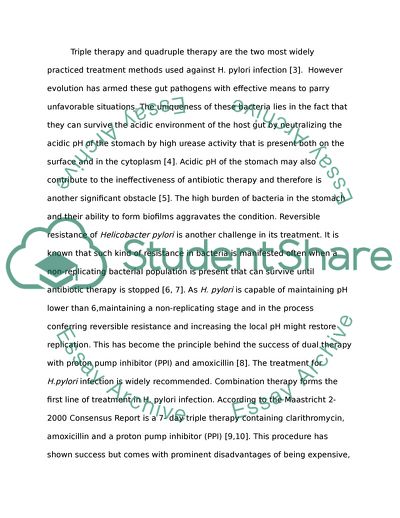Cite this document
(Helicobacter pylori cause serious disease(s) in about 10-20% of Coursework, n.d.)
Helicobacter pylori cause serious disease(s) in about 10-20% of Coursework. https://studentshare.org/health-sciences-medicine/1723235-helicobacter-pylori-cause-serious-diseases-in-about-10-20-of-infected-individuals-current-treatment-regimes-involve-a-combinatorial-approach-and-include-the-use-of-two-antibiotics-and-one-proton-pump-inhibitor-however-an-increase-in-the-emergence-o
Helicobacter pylori cause serious disease(s) in about 10-20% of Coursework. https://studentshare.org/health-sciences-medicine/1723235-helicobacter-pylori-cause-serious-diseases-in-about-10-20-of-infected-individuals-current-treatment-regimes-involve-a-combinatorial-approach-and-include-the-use-of-two-antibiotics-and-one-proton-pump-inhibitor-however-an-increase-in-the-emergence-o
(Helicobacter Pylori Cause Serious disease(s) in about 10-20% of Coursework)
Helicobacter Pylori Cause Serious disease(s) in about 10-20% of Coursework. https://studentshare.org/health-sciences-medicine/1723235-helicobacter-pylori-cause-serious-diseases-in-about-10-20-of-infected-individuals-current-treatment-regimes-involve-a-combinatorial-approach-and-include-the-use-of-two-antibiotics-and-one-proton-pump-inhibitor-however-an-increase-in-the-emergence-o.
Helicobacter Pylori Cause Serious disease(s) in about 10-20% of Coursework. https://studentshare.org/health-sciences-medicine/1723235-helicobacter-pylori-cause-serious-diseases-in-about-10-20-of-infected-individuals-current-treatment-regimes-involve-a-combinatorial-approach-and-include-the-use-of-two-antibiotics-and-one-proton-pump-inhibitor-however-an-increase-in-the-emergence-o.
“Helicobacter Pylori Cause Serious disease(s) in about 10-20% of Coursework”. https://studentshare.org/health-sciences-medicine/1723235-helicobacter-pylori-cause-serious-diseases-in-about-10-20-of-infected-individuals-current-treatment-regimes-involve-a-combinatorial-approach-and-include-the-use-of-two-antibiotics-and-one-proton-pump-inhibitor-however-an-increase-in-the-emergence-o.


